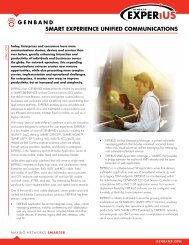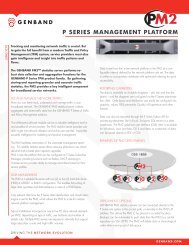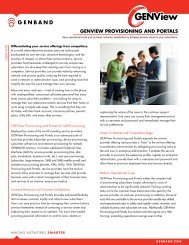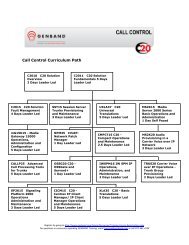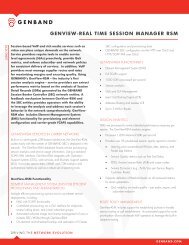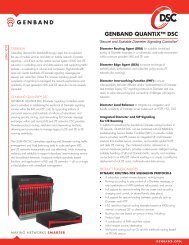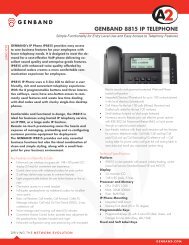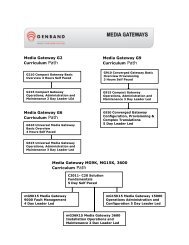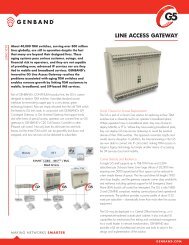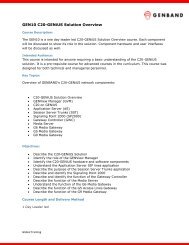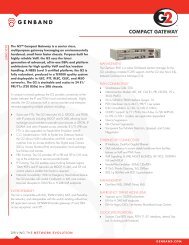session management in an enterprise comunication ... - Genband
session management in an enterprise comunication ... - Genband
session management in an enterprise comunication ... - Genband
You also want an ePaper? Increase the reach of your titles
YUMPU automatically turns print PDFs into web optimized ePapers that Google loves.
SESSION MANAGEMENT IN AN ENTERPRISE COMUNICATION NETWORK<br />
Operation Expenditure Benefits:<br />
• Enables lower carrier access <strong>an</strong>d feature rates<br />
• Network-wide least cost rout<strong>in</strong>g reduces telephony<br />
expenses<br />
• Provides evidence for SLAs with service provider (loss<br />
recovery)<br />
• Reduces labor required to support configuration <strong>an</strong>d<br />
ma<strong>in</strong>ten<strong>an</strong>ce of dial pl<strong>an</strong>s across PBXs<br />
• Reduces cost of SDR collection/aggregation<br />
• Enables carrier bypass through <strong>enterprise</strong>-to-<strong>enterprise</strong><br />
VoIP peer<strong>in</strong>g<br />
Capital Expenditure Benefits:<br />
• Leverages exist<strong>in</strong>g <strong>in</strong>vestments through protocol <strong>an</strong>d<br />
vendor <strong>in</strong>terwork<strong>in</strong>g<br />
• Avoids over-provision<strong>in</strong>g to ensure network supports realtime<br />
data<br />
As previously discussed, GENBAND’s <strong>in</strong>telligent <strong>session</strong> <strong>m<strong>an</strong>agement</strong><br />
system complements IP-PBX offer<strong>in</strong>gs <strong>an</strong>d delivers<br />
signific<strong>an</strong>t customer benefits that are unique <strong>in</strong> the <strong>in</strong>dustry.<br />
Session <strong>m<strong>an</strong>agement</strong> differentiates <strong>an</strong> <strong>enterprise</strong> bid from<br />
competitive bids.<br />
GENView Real-Time Session M<strong>an</strong>agement (RSM)<br />
The GENView RSM complements the GENBAND S3 SBC by<br />
provid<strong>in</strong>g automatic feedback of network behavior, SLA or<br />
threshold check<strong>in</strong>g <strong>an</strong>d the dynamic adjustment of <strong>session</strong><br />
devices <strong>an</strong>d <strong>in</strong>terconnects. The feedback provides <strong>enterprise</strong>s<br />
with a highly predictive, scalable service architecture for <strong>session</strong><br />
based applications. In addition, the RSM is designed to<br />
provide the network adm<strong>in</strong>istrators with a s<strong>in</strong>gle po<strong>in</strong>t from<br />
which they control <strong>an</strong>d assess the perform<strong>an</strong>ce of <strong>session</strong>s<br />
travers<strong>in</strong>g the GENBAND SBC.<br />
RSM Architecture<br />
The RSM runs on a st<strong>an</strong>dards-based Intel hardware platform<br />
host<strong>in</strong>g a carrier-grade L<strong>in</strong>ux-based operat<strong>in</strong>g system. The<br />
GENView RSM architecture is illustrated <strong>in</strong> Figure 3. The RSM<br />
<strong>an</strong>d SBC run on separate hardware platforms.<br />
An RSM Agent component runs on the SBC platform, which<br />
provides the required <strong>in</strong>formation <strong>an</strong>d <strong>in</strong>terface to the RSM.<br />
The RSM Agent implements several logical modules <strong>in</strong>clud<strong>in</strong>g<br />
Figure 3 - Architecture illustrates the <strong>in</strong>teraction between the GENBAND<br />
Real-time SessionM<strong>an</strong>ager (RSM) <strong>an</strong>d the S-Series SBC<br />
the SDR server, J server Interface <strong>an</strong>d logPP <strong>in</strong> the SBC. The<br />
SDR server reads the SDRS files created by the SBC <strong>an</strong>d<br />
delivers them to the RSM server us<strong>in</strong>g st<strong>an</strong>dard HTTP or<br />
HTTPS. The delivery of SDRs is via POST mech<strong>an</strong>isms with<br />
up to 2500 SDRs per second supported. Optionally, the SBC<br />
c<strong>an</strong> be configured to stream SDRs to third-party databases.<br />
Similarly, log files gathered at the SBC may be forwarded<br />
to the RSM server us<strong>in</strong>g logPP agent component, for further<br />
<strong>an</strong>alysis. This enables service operators to react to alarms<br />
<strong>an</strong>d events <strong>in</strong>dicat<strong>in</strong>g threshold cross<strong>in</strong>gs <strong>in</strong> either the <strong>session</strong><br />
perform<strong>an</strong>ce or health of the <strong>session</strong> elements. The RSM may<br />
be set up to dynamically update route tables at the SBC when<br />
react<strong>in</strong>g to <strong>session</strong> status <strong>an</strong>d health.<br />
The RSM is supported by a web-based RSM client. Additionally,<br />
the RSM web-services API provides northbound <strong>in</strong>terface<br />
for programmatic flow-through provision<strong>in</strong>g. Service operators<br />
<strong>an</strong>d NOC personnel c<strong>an</strong> use their browsers to remotely<br />
m<strong>an</strong>age the GENBAND entities or <strong>in</strong>tegrate with exist<strong>in</strong>g<br />
<strong>m<strong>an</strong>agement</strong> tools via the web services API.<br />
The GENBAND RSM supports these <strong>session</strong> <strong>m<strong>an</strong>agement</strong><br />
tasks:<br />
• Policy <strong>an</strong>d route <strong>m<strong>an</strong>agement</strong> for Call Admission Control<br />
(CAC)<br />
• Quality of Service <strong>an</strong>d Service Level M<strong>an</strong>agement<br />
• Service visibility <strong>an</strong>d perform<strong>an</strong>ce records<br />
7



